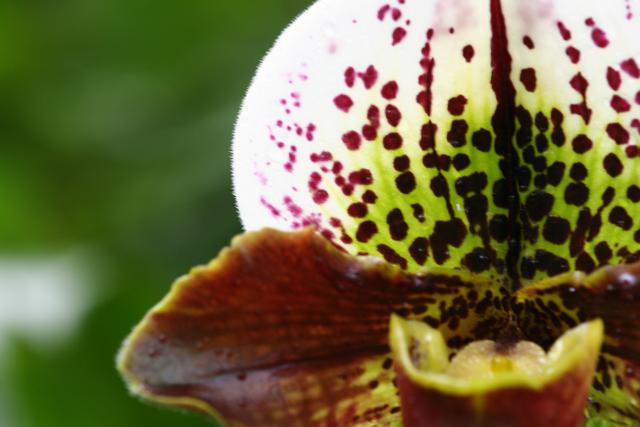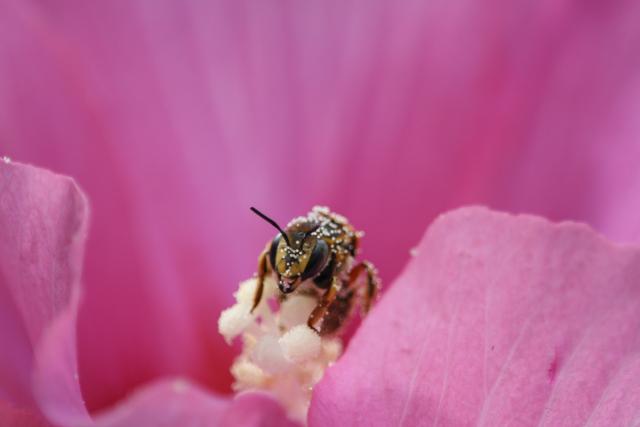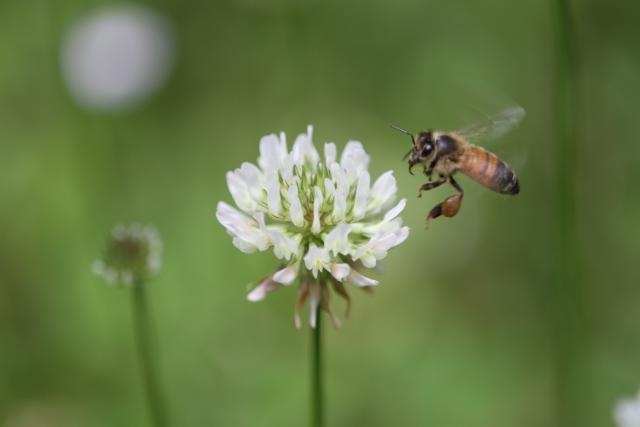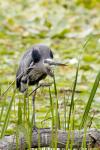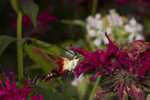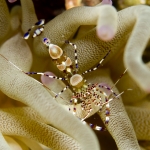flowers
Offset Orchid
ktuli — Thu, 10/21/2010 - 19:54
Another thing I do when I'm struggling is let you do the critique work... so drop me a comment and let me know what you think about this one.
Technical Data: Canon EOS Digital Rebel XT, Tamron 180mm f/3.5 Di SP LD 1:1 Macro, 1/8 sec at f/7.1. ISO 400. No post production. Phipps Conservatory, Pittsburgh, PA.
Bees and Flowers (part 3)
ktuli — Wed, 10/13/2010 - 12:50
Alright - just a last photo of bees and flowers.
Technical Data: Canon EOS Digital Rebel XT, Tamron 180mm f/3.5 Di SP LD 1:1 Macro, 1/160 sec at f/5.6. ISO 400. No post production. Taken in our own backyard.
What Works: Focus is tack sharp - the detail in the bee is spot on, and the water droplets on the upper flower are nice and crisp. Despite being an outdoor shot, the exposure is nicely done with no over or under exposed areas.
What Doesn't Work: The composition isn't exactly super strong, especially with the bee's head being partially hidden within the flower - perhaps a lower angle would have worked better. Also, perhaps isolating a single flower with the bee would have worked a little better.
- Bill
Bees and Flowers (part 2)
ktuli — Thu, 10/07/2010 - 20:47
Alright - here's day two of the bees and flowers.
Technical Data: Canon EOS Digital Rebel XT, Tamron 180mm f/3.5 Di SP LD 1:1 Macro, 1/800 sec at f/3.5. ISO 400. No post production. Taken in our own backyard.
What Works: The focus is tack sharp on the bee's face. The macro lens really does a great job of magnifying the subject - you can even make out single grains of pollen (apologies if that makes your allergies act up). The foreground petals of the flower do a great job of framing the main subject.
What Doesn't Work: I could have used a smaller aperture to get a slightly deeper depth of field and get the entire bee in focus. Perhaps a catch-light in the closer eye would have been a nice finishing touch.
- Bill
Bees and Flowers (part 1)
ktuli — Thu, 10/07/2010 - 10:05
Well, summer has officially been over for a couple weeks now, and the weather is quickly following suit. Which means that sights like these are all but over for a while.
Fall is probably one of my favorite seasons - the cooler weather is more conducive to outdoor activities, hockey season starts back up, and the fall foliage is always a wonderful gift from nature. Since we had such a hot and dry summer, I don't know colorful of a fall we'll get this year, so I figured I'd let summer linger a little longer.
Technical Data: Canon EOS 7D, Tamron 180mm f/3.5 Di SP LD 1:1 Macro, 1/510 sec at f/3.5. ISO 200. Dolica AX620B100 tripod. No post production. Kanawha State Forest, Charleston, WV.
Why This Photo: I frequently try for photos of insects in flight, and after hiking around for about five hours this day, I decided to take a break by sitting in a field of wild flowers and waiting to see what would come to me.
What Works: The shallow depth of field (which is necessary to help get the fast shutter speed to freeze the motion of the honey bee and flowers in the breeze) produces a nicely blurred background. The focus is fairly sharp, though a bit blurred on the bee itself - whether from missed focus or from motion blur. The catch-light in the bee's eye is a nice touch.
What Doesn't Work: The composition is a bit bland with the flower at the dead center of the photo, perhaps a post production vertical crop would convert this to a more functional photo.
I have a handful more flower and bee photos, so I'll get around to sharing them sooner or later.
- Bill
Grasshopper at Phipps
ktuli — Wed, 07/21/2010 - 16:01
I don't know if Phipps really likes pests like grasshoppers jumping around their greenhouses, but during out last visit we saw a couple around,
Technical Data: Canon EOS 7D, Tamron 180mm f/3.5 Di SP LD 1:1 Macro, 1/330 sec at f/9.9. ISO Auto. Canon Monopod. Phipps Conservatory, Pittsburgh, PA.
Why This Photo: Seeing this grasshopper in the conservatory was enough of a surprise and different subject for in the gardens, that it was a pleasant alternative to the usual subjects there. I would have liked to have shot with a tripod, but at least the monopod helped a bit.
What Works: I like the tack sharp focus coupled with just the right amount of depth of field. The foreground flower and grasshopper are in focus, but the background is soft and the additional blurred flower provides a nice reference point and additional focal 'distraction' for multiple points for the viewer's eyes to wander to.
What Doesn't Work: The framing might be better slightly pulled back to not cut off the flower in the foreground, or alternatively just a lower angle shot to get more of profile shot of the grasshopper.
Do you see anything you like or dislike about this photo? Drop me a comment and let me know.
- Bill
Poll: Break from the Bugs
ktuli — Mon, 05/31/2010 - 17:31
So I guess we can take slight break from all the bugs (though if you've missed them, scroll down and check them out).
I took these two photos specifically with the thought in mind to try multiple framing options for a subject.
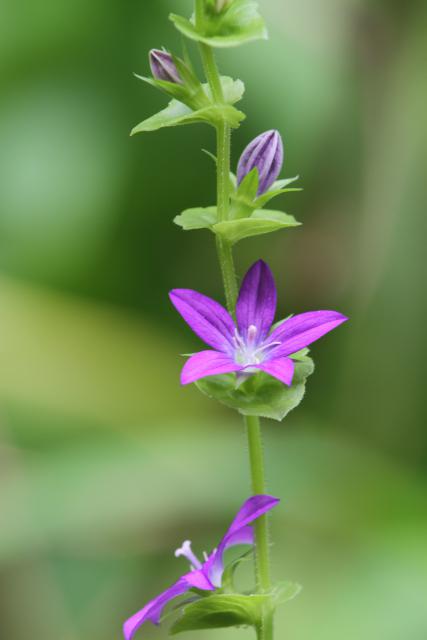
Close Crop
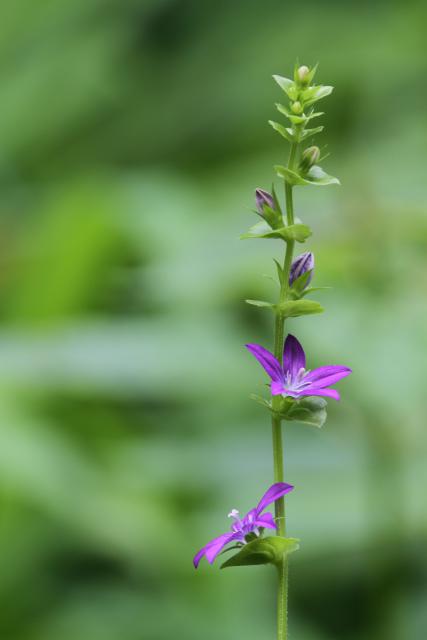
Wider Crop
Technical Data: Canon EOS 7D, Tamron 180mm f/3.5 Di SP LD 1:1 Macro, 1/32 and 1/50 sec at f/8. ISO 200. Dolica AX620B100 tripod. No post production. Kanawha State Forest, Charleston, WV.
Unfortunately I was using a prime lens, so I actually had to move the whole camera, so these aren't necessarily identical framing, but I still like both. Vote for your favorite and drop me a comment to let me know why.
- Bill
Crab Spider (part 3)
ktuli — Mon, 04/19/2010 - 20:26
So we're closing in on the end of the available photos from this crab spider. Towards the end of the shoot, this little guy definitely let me know he was getting tired of me.
That is definitely something you need to be conscientious of when working with any kind of wildlife photography. Your subject will definitely let you know when you need to back off. Ideally, you want to be done with your photos well before that time comes - both for the health of your subject as well as for the natural behavior to be captured in your images.
It is a little tougher to identify those warning signals with small insects and spiders. This is definitely one, though.
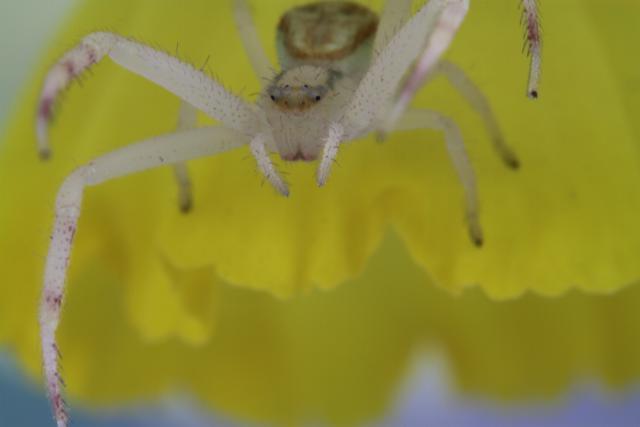
Technical Data: Canon EOS 7D, Tamron 180mm f/3.5 Di SP LD 1:1 Macro with Kenko Teleplus PRO 300 "DG" AF 2x Teleconverter for effective 360mm with 68mm in extension tubes. 1/2 sec at f/9.1 and exposure compensation +1/3 stop. ISO 200. No post production.
Why This Photo: I was just working the subject as much as I could before having to pack it in. At this point, almost any motion caused him to rear up and posture aggressively (earlier in the shoot, it took dramatic motions or very loud noises like my dog barking). At this point, he was charging to the edge of the flower and waving his front limbs around like crazy. I had him framed and set for what I thought would be a great shot, and as I pressed the shutter release and started the timer, he waves his limbs around again, and I just had to get whatever posture he ended up in when the timer ended.
What Works: Focus is sharp, and I like the overall exposure. I like how the edge of the flower was visible in this shot - so many of the shots in this set were so zoomed in that it wasn't always apparent that this was on a flower.
What Doesn't Work: The original framing had all parts of the spider inside the shot, but after he decided to flail about wildly, that wasn't the case for the final shot. I could have not framed the original shot so tightly, but then I would be sacrificing some of the magnification.
One other thing I was going for with this shot was to capture the nice greenish color on the abdomen of the spider. It really was very beautiful. You can catch a hint of it here, but unfortunately, I don't think I did such a good job of capturing that. I didn't manage to get it in any of the photos in this set.
What do you think?
- Bill
Poll: Crab Spider (part 2)
ktuli — Wed, 04/14/2010 - 19:02
If you haven't read part 1 yet, definitely check it out.
I've said this before here, but when you find a subject worth shooting, take your time and work with the subject. I kept over thirty exposures (and took probably twice that many but deleted the completely worthless ones) from a span of over two hours of working with this spider.
Definitely work your subject.
With that in mind, I kept trying different exposure levels. Here are four different exposures - take a look and vote below for your favorite. Despite the great variance in the look of these photos, these are straight out of the camera with no post production.

Version 1: 1/5 sec at f/9.1 with pop-up flash. IMG_0998
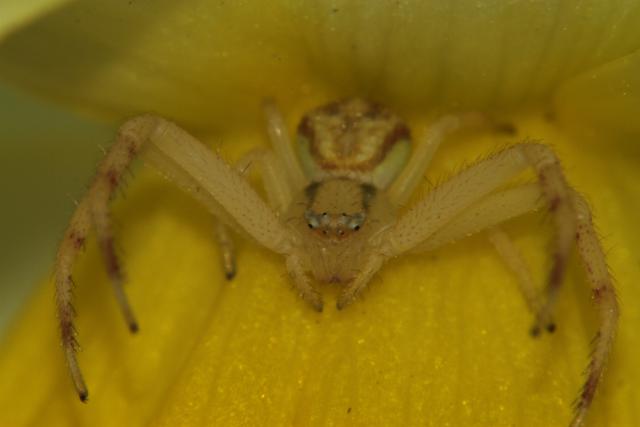
Version 2: 1/10 sec at f/9.1 with pop-up flash and exposure compensation -1 stop. IMG_0999
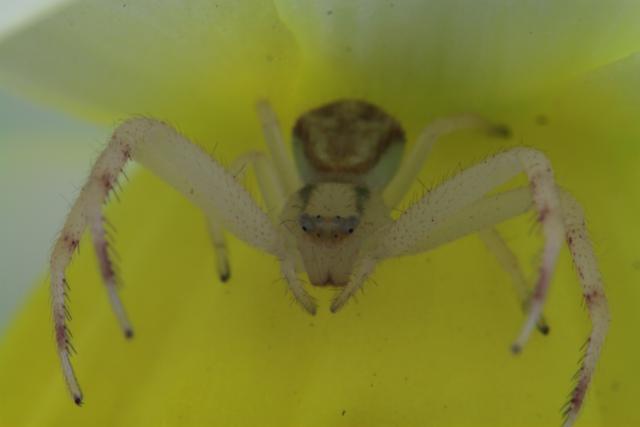
Version 3: 1/3 sec at f/9.1 with no flash and exposure compensation -1/3 stop. IMG_1000
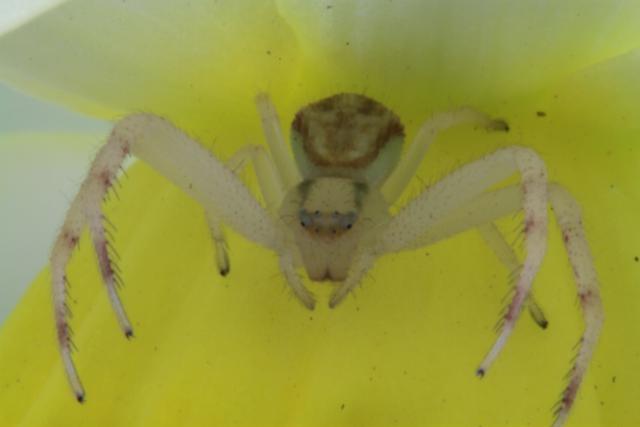
Version 4: 4 sec at f/25.8 with no flash. IMG_1001
Pretty different, huh? If you use tabs in your browser, I recommend opening each image in a different tab (usually control+clicking the link) and switching between the tabs to see the distinct difference between the images (scrolling through them sometimes makes it tougher to compare.
General Technical Data:Canon EOS 7D, Tamron 180mm f/3.5 Di SP LD 1:1 Macro with Kenko Teleplus PRO 300 "DG" AF 2x Teleconverter for effective 360mm with 68mm in extension tubes. ISO 200. No post production.
One of these will definitely be submitted to a couple upcoming contests. I just need to figure out which one I like best.
What do you think? Vote below, and then leave a comment and let me know why you chose the version you did.
- Bill
Crab Spider (part 1)
ktuli — Tue, 04/13/2010 - 20:36
I've seen photos of crab spiders before, and I've always thought they were awesome spiders. When I found one in our own garden, I was amazed. I spent the better portion of the evening photographing it.
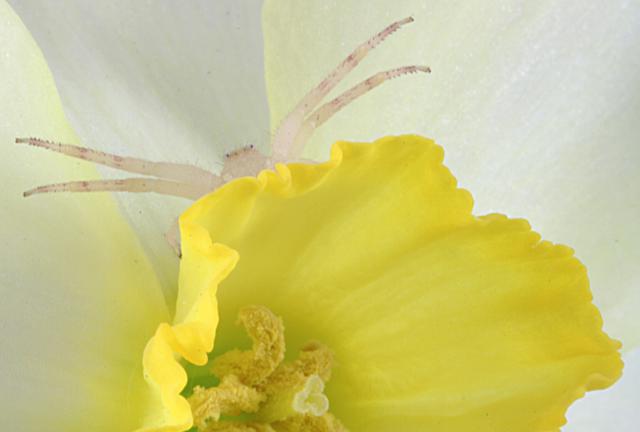
Technical Data: Canon EOS 7D, Tamron 180mm f/3.5 Di SP LD 1:1 Macro with Kenko Teleplus PRO 300 "DG" AF 2x Teleconverter for effective 360mm. 1 second at f/28.1. ISO 200. Post Production: Sharpen 100% 15 pixels, cropped (original).
Why This Photo: This is the first crab spider I've seen, so I took as many photos as I could. It was fairly aggressive and would posture like this whenever loud noises or quick motions happened. I wanted to try and capture that aggressive posturing.
What Works: I did some of the things I've been meaning to try and keep in mind with my macro work. The kind of stuff I did to try and make this photo better include:
- Used a tripod
- Smaller aperture for greater depth of field
- Timer delay (since I still don't have a remote trigger)
- Live View with zoom for better focusing
- Generous framing to allow for cropping if necessary
What Didn't Work: I wasn't thrilled with the framing, but since I left enough room, I was able to crop it down to something I liked more. The image was a bit out of focus, but I was able to sharpen it a little in Photoshop. I keep debating the exposure levels, feeling that the image is a bit blown out, but haven't been able to adjust the levels in Photoshop to my liking - though the cropping removed some of the problem by removing some of the extra areas of white flower pedals.
Working on these photos helped me to feel like I've come along way and have started to put some of the things I've learned into practice. At the same time, they's showed me how much more I have to learn.
What do you think? How did I do with this very special subject to shoot?
- Bill
Aphids on Rosebud
ktuli — Tue, 04/06/2010 - 19:43
I submitted this photo to the Photographic Section's second digital projected image competition of the year.
I really liked this photo. Unfortunately, it didn't do so well in the judging.
Technical Data: Canon EOS Digital Rebel XT, Tamron 180mm f/3.5 Di SP LD 1:1 Macro, 1/250 sec at f/4. ISO 400. No post production. Taken in our backyard.
Why This Photo: I originally was in the yard photographing an insect I had never seen before (but turned out to be a ladybug larva and I'll share some of those photos eventually) when I saw this rosebud covered in aphids. I steadied the lens by leaning against our fence and squeezed off as many photos as I could.
What Works: The focus is tack sharp, and the shallow depth of field produces a perfectly blurred background providing a soft green background. The rose sits on one of the thirds lines with the lean of the rosebud is towards the center of the photo keeping the viewers attention from wandering.
What Doesn't Work: I honestly don't think there is much wrong with this photo. I didn't agree with any of the critiques this photo received at the competition, and since I can't think of any I'll just leave it open.
I did remove the sensor dust spots in the version I submitted for competition. That would be the two dark spots on the left side of the photo. We've since cleaned the sensor on our camera to remove future occurrences of that.
What do you think? Is this photo as strong as I think? Or can you find things you don't like about it?
Leave me a comment and let me know what you think.
- Bill

